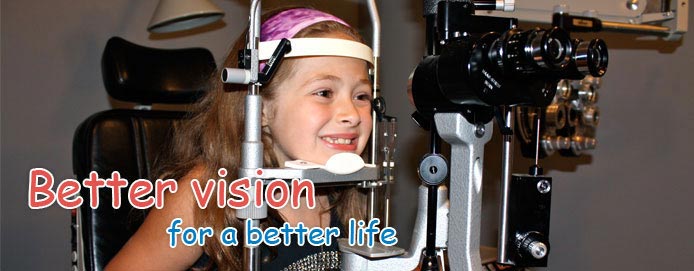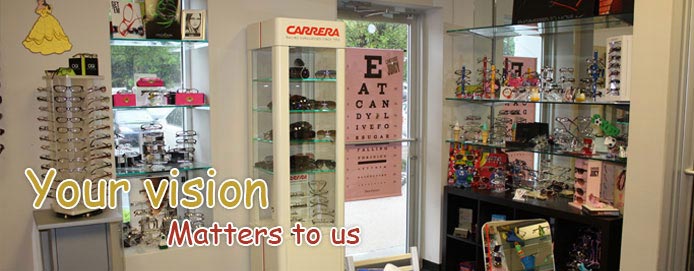Services
Comprehensive eye exams
Our doctors provide comprehensive eye exams to all of our pediatric patients. This includes an assessment of visual acuity, eye alignment, depth perception (stereopsis), evaluation of the anterior segment (front portion of the eye including the cornea and lens), evaluation of the posterior segment (retina and optic nerve) and refraction. The refraction is the determination of the optical properties of the eye.
This includes evaluation for myopia (nearsightedness), hyperopia (farsightedness), and astigmatism. This measurement can be done for patients of all ages. It is based on the length of the eye, the curvature of the surface of the eye, and the power of the natural lens inside the eye.
Using an instrument called a retinoscope and various lenses we can determine whether or not your infant or child requires glasses. In children the refraction is measured after dilation of the pupils. The dilating drops will decrease your child’s ability to adjust the focusing power of their eyes and will allow us to accurately determine whether or nor glasses are needed.
Nasolacrimal duct obstruction (blocked tear duct)
Occasionally infants are born with a clogged tear duct on one or both sides.Normally, the tears drain from an opening in the inner corner of the eyelids (the punctum) into the nose.
When the tear duct is blocked the child can have symptoms of tearing, discharge or both.At times the blockage will resolve on its own.This typically occurs by the time the child is 1 year old.
If the blockage has not resolved on its own a procedure called “probing and irrigation” can be done to open the tear duct.There is no incision made during this procedure.A blunt probe is placed from the punctum in the eyelid down the nasolacrimal system to create an opening.
Additionally your doctor may chose to dilate the tear duct with a balloon catheter (which is removed at the time of the procedure) or place a tube in the tear duct.Depending on the age of your child your doctor may offer you the option of having the probing procedure performed in the office.
For more information, please click on the below links:
- http://www.aapos.org/terms/conditions/72
- http://www.geteyesmart.org/eyesmart/diseases/blocked-tear-duct.cfm
Screening for Retinopathy of Prematurity
When infants are born prematurely the blood vessels in the retina (inner most layer of the eye) have not completed their development.In certain infants these blood vessels can grow abnormally once the baby is outside of the womb.
There are multiple stages of abnormal blood vessel growth, the most severe of which can lead to significant vision loss.
If a baby is determined to have higher stages of retinopathy of prematurity, treatment such as laser applied to the retina can often prevent vision loss.
Infants born at 30 weeks gestational age or under and babies born with a birth weight of less than 1500 grams are at risk for developing retinopathy of prematurity.
Our ophthalmologists offer screening eye exams for retinopathy of prematurity in several neonatal intensive care units on Long Island and in Manhattan and in the office once your child is discharged.Development of the retinal blood vessels is often complete by your due date or shortly after in most infants.
For more information, please click on the below links:
Evaluation and treatment for Pediatric Cataracts
A cataract is any opacity in the lens. A normal lens should be clear. Infants can be born with a cataract in one or both eyes or develop a cataract later in childhood.
Cataracts can be genetic, caused by metabolic disorders or infection, or they can be isolated (most common). Not all cataracts require surgery.
If the cataract is significant enough to block the child’s vision then cataract surgery is performed. If your child has a cataract it is important to have a complete eye evaluation to determine if the opacity is affecting the child’s vision as this can lead to amblyopia (lazy eye).
The goal of the surgery is to provide a clear visual pathway. Depending the age of the child at the time of surgery, a lens implant may be placed in the eye or the child may be treated with a contact lens or glasses.
If your child requires a contact lens our doctors will teach you how to insert and remove the lens and how to care for the lens. Certain small cataracts do not require surgery but my cause anisometropia (a difference in the refractive error between the two eyes). In this situation glasses may often prevent development of amblyopia.
For more information, please click on the below links:
Amblyopia (Lazy eye)
The term amblyopia or lazy eye refers to a decrease in vision in one or both eyes with no structural abnormality to the eye itself.
Some of the most common causes of amblyopia are an eye turn or misalignment (strabismus), anisometropia or unequal glasses prescription between the two eyes, high hyperopia, significant astigmatism, and cataracts.Every child with an eye turn does not have amblyopia.
A comprehensive exam will allow your doctor to determine if your child has amblyopia or could be at risk for developing amblyopia.
Treatment of your child’s amblyopia will depend on the underlying cause.At times, glasses are the first step in treating amblyopia.Glasses will allow both eyes to be in focus at the same time.The vision may not immediately improve with the glasses.
The glasses will put things in focus and train your child’s eye to see better over time.Some children will need occlusive therapy or patching as treatment.Patching the better seeing eye will help to strengthen the vision in the amblyopic eye.
As an alternative to patching your doctor may consider using a drop which dilates the pupil in the better seeing eye. This blurs the vision in the better seeing eye, encouraging the brain to use the amblyopic eye more.
For more information, please click on the below links:
Esotropia
Esotropia is more commonly known as crossed-eyes. Children can be born with esotropia and this is often referred to as congenital esotropia or infantile esotropia.
These children often have significant amounts of eye crossing and are often candidates for surgical correction between the ages of 6 months and 2 years.
Other children develop esotropia between the ages of 2 years – 4 years. These children are often far-sighted (hyperopic) and spectacles will help correct the crossing.
Some children with increased amounts of eye crossing for near work will need a bifocal in the spectacles to correct the crossing. This is often referred to as accommodative esotropia.
If crossing is still noted with the spectacles surgical correction of the crossing is offered. Children with esotropia may also develop amblyopia and need patching if one eye crosses more than the other or if the amount of far-sightedness is higher in one eye than the other.
For more information, please click on the below links:
Exotropia
Exotropia is outward drifting of an eye.This can be constant or intermittent.
A child with exotropia may or may not have amblyopia. Your doctor will perform a complete eye examination to determine if there are any associated vision problems, and to determine if your child needs glasses and/or patching. Your doctor will also determine whether your child is a candidate for surgical correction of the exotropia.
For more information, please click on the below links:
Abnormal head position/Torticollis
Various types of eye misalignment may lead to abnormal head position (head tilt or head turn). When the eyes are misaligned in certain gazes you will position your head in the opposite gaze to have the least amount of misalignment.
One condition which leads to a head tilt is known as a 4th nerve palsy or superior oblique palsy. This can be congenital or acquired, and can occur in one eye or both. With a superior oblique palsy the superior oblique muscle of one eye is weaker or more lax as compared with the other eye leading to an eye misalignment in certain gazes. The main job of the superior oblique muscle is to rotate the eye and help move the eye vertically. Someone with a superior oblique palsy will often tilt their head in the opposite direction from the eye with the weaker muscle.
A syndrome called Brown’s syndrome occurs when the superior oblique muscle on one side is tighter than the muscle on the opposite side. This eye will not elevate as well as the opposite eye and may result in chin up positioning. Brown’s syndrome can also be congenital or acquired.
Children with Duane’s Syndrome will often have a head turn to the left or right. Duane’s syndrome results from a miswiring of the muscles that control horizontal eye movement. Children with any of these types of strabismus may be candidates for surgical correction and should have a complete eye exam to evaluate for any signs of amblyopia.
For more information, please click on the below links:
- http://www.aapos.org/terms/show/8
- http://www.aapos.org/terms/show/52
- http://www.aapos.org/terms/show/29
- http://www.aapos.org/terms/show/46
Ptosis
Some children are born with a weak eyelid muscle on one or both sides. This can lead to amblyopia in one of 2 ways. If severe enough it can block your child’s vision by covering the pupil or it can cause a significant amount of astigmatism.
Children with ptosis should be monitored for signs of amblyopia at regular intervals. If your child is developing amblyopia a surgical procedure to lift the eyelid may be offered.
In addition some children with ptosis may elevate their chin to see well. This can also be an indication for surgical correction. If the ptosis is mild and there is no amblyopia it may be best to defer surgery for cosmetic reasons until the child is school age or older.
For more information, please click on the below links:
Adult Strabismus
Adults who develop strabismus (eye misalignment) often develop diplopia (double vision). One option to alleviate double vision is spectacles with prism. The objective of the prism is to superimpose the two images, creating a single image.
Some patients with double vision may be candidates for surgical correction of their eye misalignment which may also correct the double vision. During the strabismus evaluation your doctor will evaluate your eye alignment and eye movement to determine the appropriate treatment.
Some causes of new onset strabismus in adults include 3rd nerve palsy, 4th nerve palsy, 6th nerve palsy, thyroid eye disease, vascular disease and trauma.
Some adults have a history of strabismus as a child. If you chose not to have surgery to correct the eye misalignment as a child you may still have the opportunity to have the strabismus corrected as an adult. In addition some adults have a history of one or more previous strabismus surgeries as a child but notice a change in the eye position over time and may be interested in additional surgery.
Strabismus surgery is considered reconstructive surgery not cosmetic surgery. In addition to the improved appearance of ocular realignment many patients experience an improvement in visual function.
For more information, please click on the below links:
- http://www.aapos.org/terms/show/11
- http://www.aapos.org/terms/show/104
- http://www.aapos.org/terms/show/52
- http://www.aapos.org/terms/show/98
- http://www.aapos.org/terms/show/105
Contact Lens fitting
Some children who wear glasses are interested in wearing contact lenses. If your child is interested in wearing contact lenses you can schedule a contact lens fit appointment with one of our optometrists. During the appointment we will determine which type of contact lens will fit best and suit your child’s needs best. Contact lenses come in different sizes (different curvatures and diameters) to fit each individual eye. In addition your child will receive training on proper insertion and removal of the contact lenses.




